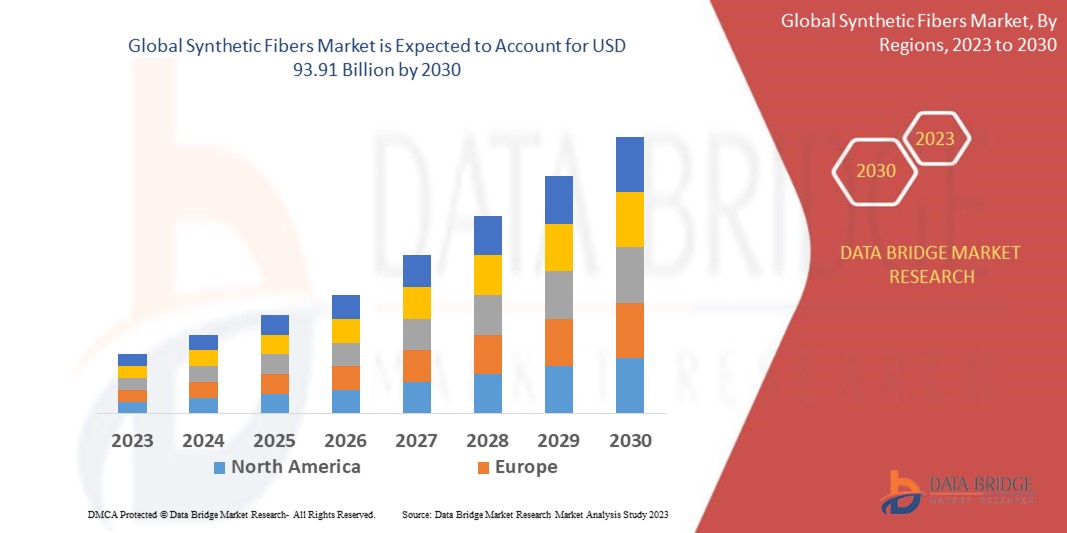
Executive Summary Synthetic Fibers Market Opportunities by Size and Share
Data Bridge Market Research analyses that the global synthetic fibres market which was USD 65.53 billion in 2022, is expected to reach USD 93.91 billion by 2030, growing at a CAGR of 4.60% during the forecast period of 2023 to 2030.
To achieve detailed market insights and keep market place clearly into the focus, such wide-ranging Synthetic Fibers Market research report has to be there in the picture. Each of these chapters is researched and analysed in detail for formulating a comprehensive market research report. In addition, competitor analysis is performed very well in the first class Synthetic Fibers Market report which takes into account vital aspects about the key players in the market such as strong and weak points of the competitors and analysis of their strategies with respect to product and market.
A team of innovative analysts, passionate forecasters, knowledgeable researchers and experienced industry experts work keenly and 24*7 to produce the most excellent Synthetic Fibers Market report. It is an essential document for every market enthusiast, policymaker, investor, and market player. This market report endows clients with the information on their business scenario with which they can build business strategies to thrive in the market. Confidently trust on the information offered in this market research report as it is derived only from the valuable and genuine resources. The persuasive Synthetic Fibers Market report is provided with full commitment by assuring the best possible service depending upon business requirements.
Analyze top trends and market forces impacting the Synthetic Fibers Market. Full report ready for download:
https://www.databridgemarketresearch.com/reports/global-synthetic-fibers-market
Current Scenario of the Synthetic Fibers Market
**Segments**
- By Type: Based on type, the global synthetic fibers market can be segmented into polyester, nylon, acrylic, polyolefin, and others. Polyester fibers are widely used in the textile industry due to their durability, wrinkle resistance, and ease of maintenance. Nylon fibers are known for their strength and elasticity, making them ideal for a range of applications such as apparel, carpets, and industrial materials. Acrylic fibers are often used as a wool substitute in clothing and home textiles. Polyolefin fibers, including polypropylene and polyethylene, are valued for their moisture resistance and thermal properties.
- By Application: The market can be segmented by application into apparel, home furnishings, automotive, filtration, and others. The apparel segment dominates the market due to the widespread use of synthetic fibers in clothing and accessories. Home furnishings, including carpets, curtains, and upholstery, also account for a significant share of the market. The automotive industry utilizes synthetic fibers for interior fabrics, seat covers, and insulation, while the filtration sector relies on these materials for air and liquid filtration products.
- By Region: Geographically, the global synthetic fibers market is segmented into North America, Europe, Asia Pacific, Latin America, and Middle East & Africa. Asia Pacific is the largest market for synthetic fibers, driven by the presence of key textile manufacturing countries such as China, India, and Bangladesh. North America and Europe also contribute significantly to the market value, thanks to the demand for innovative synthetic fiber products in advanced industries.
**Market Players**
- Indorama Ventures Public Company Limited
- Toray Industries, Inc.
- China Petroleum & Chemical Corporation (Sinopec)
- Reliance Industries Limited
- E. I. du Pont de Nemours and Company
- Mitsubishi Chemical Holdings Corporation
- Asahi Kasei Corporation
- Kolon Industries, Inc.
- Teijin Limited
- Bombay Dyeing
These market players are at the forefront of the global synthetic fibers market, continuously innovating and expanding their product portfolios to meet the evolving demands of various industries. Strategic partnerships, acquisitions, and investments in research and development are common strategies adopted by these companies to maintain their competitive edge in the market.
The global synthetic fibers market is witnessing significant growth trends driven by several key factors. One emerging trend in the market is the increasing focus on sustainable and environmentally friendly synthetic fibers. With growing awareness of the environmental impact of traditional synthetic fibers, manufacturers are investing in research and development to create eco-friendly alternatives. Innovations such as recycled polyester fibers and bio-based nylon are gaining traction in the market as consumers and industries seek more sustainable options.
Another notable trend is the rising demand for high-performance synthetic fibers in technical applications. Industries such as aerospace, defense, and sports equipment are increasingly turning to advanced synthetic fibers for their unique properties such as high strength, durability, and resistance to extreme conditions. The development of specialized fibers tailored to meet the specific needs of these industries is driving innovation and expanding the market potential for synthetic fibers.
Moreover, evolving fashion trends and preferences are shaping the demand for synthetic fibers in the apparel industry. Consumers are seeking garments that offer both comfort and style, leading to the adoption of synthetic fibers with enhanced properties such as moisture-wicking, UV protection, and stretch capabilities. Manufacturers are responding to these demands by incorporating advanced technologies and materials into their product offerings to stay competitive in the fast-paced fashion market.
Additionally, the COVID-19 pandemic has had a significant impact on the global synthetic fibers market. With disruptions in supply chains and shifts in consumer behavior, the market experienced fluctuations in demand and production. However, the crisis also highlighted the resilience of synthetic fibers as versatile materials that can be adapted for various applications, including the production of protective gear, medical textiles, and hygiene products.
Looking ahead, the global synthetic fibers market is poised for continued growth and innovation as market players focus on sustainability, performance, and versatility in their product development strategies. Collaborations between manufacturers, researchers, and end-users are expected to drive advancements in fiber technology and open up new opportunities in diverse industries. As the market evolves, adaptability and agility will be key factors for companies seeking to thrive in the competitive landscape of the global synthetic fibers market.The global synthetic fibers market is a dynamic and evolving industry that is driven by a variety of factors such as changing consumer preferences, technological advancements, and environmental concerns. One of the key trends shaping the market is the increased focus on sustainability and eco-friendly alternatives. As consumers become more environmentally conscious, there is a growing demand for synthetic fibers that are recycled or bio-based. This shift towards sustainability is encouraging manufacturers to invest in research and development to create innovative and eco-friendly synthetic fiber products to meet the changing demands of the market.
Another important trend in the synthetic fibers market is the rising demand for high-performance fibers in technical applications. Industries such as aerospace, defense, and sports equipment require synthetic fibers with superior strength, durability, and resistance to extreme conditions. This has led to the development of specialized fibers that cater to the specific needs of these industries, driving innovation and expanding the market potential for synthetic fibers.
In the apparel industry, evolving fashion trends and consumer preferences are influencing the demand for synthetic fibers with enhanced properties such as moisture-wicking, UV protection, and stretch capabilities. Consumers are increasingly looking for clothing that offers both comfort and style, pushing manufacturers to incorporate advanced technologies and materials into their product offerings. This shift in consumer behavior is prompting companies in the synthetic fibers market to adapt and innovate to meet the evolving needs of the fashion industry.
The COVID-19 pandemic has also had a significant impact on the global synthetic fibers market. Disruptions in supply chains and changes in consumer behavior have led to fluctuations in demand and production. However, the crisis has highlighted the versatility of synthetic fibers as adaptable materials that can be used for various applications, including the production of protective gear, medical textiles, and hygiene products. This flexibility has allowed synthetic fiber manufacturers to pivot and adjust to the changing market conditions brought about by the pandemic.
Looking ahead, the global synthetic fibers market is poised for continued growth and innovation as companies focus on sustainability, performance, and versatility in their product development strategies. Collaboration between manufacturers, researchers, and end-users will be crucial in driving advancements in fiber technology and exploring new opportunities in diverse industries. As the market continues to evolve, companies that prioritize adaptability and agility will be best positioned to succeed in the competitive landscape of the global synthetic fibers market.
Access segment-wise market share of the company
https://www.databridgemarketresearch.com/reports/global-synthetic-fibers-market/companies
Targeted Question Batches for Synthetic Fibers Market Exploration
- What is the total global market volume of the Synthetic Fibers Market?
- How is the market expected to grow over the next five years?
- What categories hold the highest Synthetic Fibers Market value?
- Who are the leading innovators in this space?
- What new offerings are gaining Synthetic Fibers Market share?
- Which global areas are under analysis in the Synthetic Fibers Market report?
- What is the fastest-growing country within each region?
- Which countries are scaling production capacities?
- What zones are seen as future growth hubs?
- What trends are disrupting conventional business models?
Browse More Reports:
Middle East and Africa Dry Eye Syndrome Treatment Market
North America Dry Eye Syndrome Treatment Market
Europe Refined Wax Market
Asia-Pacific Refined Wax Market
North America Refined Wax Market
Asia-Pacific Flow Chemistry Market
Europe Flow Chemistry Market
North America Flow Chemistry Market
Middle East and Africa Flow Chemistry Market
Asia-Pacific Wi-Fi Chipset Market
Europe Wi-Fi Chipset Market
Middle East and Africa Wi-Fi Chipset Market
North America Wi-Fi Chipset Market
Asia-Pacific Cartoning Machines Market
Asia-Pacific Veterinary Infusion Pumps Market
About Data Bridge Market Research:
An absolute way to forecast what the future holds is to comprehend the trend today!
Data Bridge Market Research set forth itself as an unconventional and neoteric market research and consulting firm with an unparalleled level of resilience and integrated approaches. We are determined to unearth the best market opportunities and foster efficient information for your business to thrive in the market. Data Bridge endeavors to provide appropriate solutions to the complex business challenges and initiates an effortless decision-making process. Data Bridge is an aftermath of sheer wisdom and experience which was formulated and framed in the year 2015 in Pune.
Contact Us:
Data Bridge Market Research
US: +1 614 591 3140
UK: +44 845 154 9652
APAC : +653 1251 975
Email:- [email protected]


